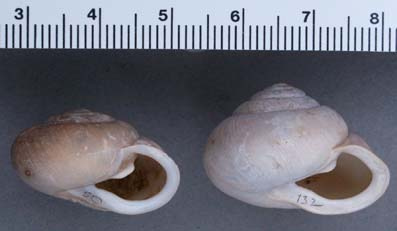The developing embryo absorbs calcium from the calcified egg shells to form the first whorl called a protoconch (Tompa, 1976). Take notice of the spirals on the shell in the photo below. These are the whorls. Interestingly, nature has provided a way to further the calcium uptake by the newly born snails. The juvenile snails, after having hatched from their egg, will consume what is left of their calcified egg shell to maximize their calcium uptake (Tompa, 1976).
The shell is composed primarily of calcium carbonate, CaCO3 (Tompa, 1976). The adult Mesodon zaletus shell consists of 5.5 to 6 whorls (Dourson, 2006). The shell is lined with transverse striations that lie perpendicular to the whorls (Dourson, 2006).
Shells composed of calcium carbonate
At maturity, the shell diameter can reach sizes of up to 24-31 mm (Emberton, 1993).
The shell is imperforate (solid) and contains a parietal tooth on
the inner wall (Dourson, 2006). Newly hatched snails have shells
that do not exhibit the parietal tooth as evident in
the adult (Emberton, 1993). Also, the shell
is dextral, meaning that it has a right-handed whorl (Franzen, 1944).
Mesodon zaletus moves with a foot, otherwise known as a
muscular base
(Coppolino, 2009). The foot contracts in a wave-like
motion in the direction
in which the snail is moving (Coppolino,
2009). However, some limitations would arise in that the foot would
possibly get stuck or friction could be too great for the snail to
move a decent distance without some sort of lubrication.
Fortunately, they have developed a means to overcome this obstacle.
Glands within their muscular foot secrete mucous to reduce friction
and aid in their movement (Coppolino, 2009). Think about it in
this
way; it is easy run and slide along a layer of ice in the winter
with rubber soled shoes, but in the summer time the coefficient of
friction is too great and rubber shoes on pavement sticks all too
well, limiting your ability to slide across the surface. The mucosal lining increases their mobility along the ground,
reducing the coefficient of friction much in the same way ice does
to rubber soled shoes, allowing the snail to move more easily across
the surface.
A graphical review of the juvenile and adult:





